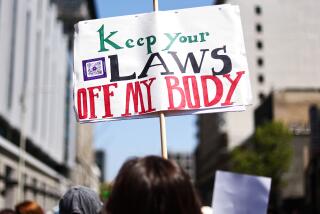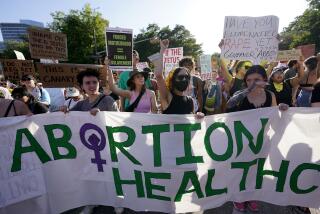The Thirty Years War
- Share via
Imagine being Roe vs. Wade at 30 and going in for your annual legal checkup only to receive the same chilling prognosis as prior years: Your heart is strong, your overall condition has not changed and you could die at any moment. It is enough to send anyone into an early midlife crisis.
This week, people will celebrate and condemn Roe. For these advocates, Roe is a cultural icon of either female emancipation or moral disintegration. It is the political question that divides the nation into pro-choice and pro-life camps.
Originally, however, it was a legal case, one that seems less understood with each passing year.
First, a correction of a common misunderstanding: The Roe that exists today is not the case that was created in 1973. When Roe was handed down by a 7-2 vote, the right to choose was recognized by the Supreme Court as a fundamental right by a strict test of review. Though a state’s authority increased in the third trimester, Roe was effectively armor-plated from hostile state legislation.
That Roe died in the Supreme Court’s 1992 ruling in Planned Parenthood vs. Casey. In that decision, Roe was saved from outright extinction by the slimmest of majorities, but at a cost. Gone was Roe’s trimester scheme, its clear status as a fundamental right and its original strict test for review. Instead, Justices Sandra Day O’Connor, Anthony Kennedy and David Souter crafted a more ambiguous test: allowing state restrictions that do not place “an undue burden” on the core right to abortion. Under this lower standard, the court upheld previously rejected state laws requiring such things as waiting periods and informed consent rules.
Because the Supreme Court has never articulated a clear and stable basis for the right to choose, it relies on the personal reluctance of individual justices to serve as the hand by which the right dies.
O’Connor and Kennedy have voted to preserve Roe despite the inherent inconsistency with their positions in other areas, particularly inherent state authority. These justices know that if Roe is overturned, the national debate would fracture into 50 blazing state debates over the availability and restrictions on abortion.
It would not take much for Roe to be overturned in its entirety. Kennedy, one of the key Casey architects, voted in 2000 against the pro-choice position in the Stenberg vs. Carhart partial-birth abortion case.
Even if Kennedy remains loyal to preserving the core protection of Roe, three key Roe supporters -- O’Connor and Justices John Paul Stevens and Ruth Bader Ginsburg -- are over 70; we are very likely to see two to four vacancies on the court by 2008.
Roe needs what the current court seems incapable of supplying: clarity. Roe itself was a maddening exercise in ambiguity, with an assortment of possible sources cited for the right of privacy. This right was further undermined by the court’s refusal in 1986 to use it to protect homosexuals from prosecution for private consensual relations.
One of the problems with Roe is that it is always treated in isolation. Though it is loosely based on a broader concept of privacy, both sides prefer to consider it an area unto itself, with unique tests and rationales.
Yet if abortion is part of a person’s privacy interests, it is part of a larger question of the right of an individual to control matters of sexual relations and sexuality, which sweeps far more broadly.
There are various possible theories upon which to replant Roe on more stable ground. Yet Roe’s supporters do not want to acknowledge that the original decision was flawed, so they rig patches for its endless theoretical leaks rather than build a new and better foundation. Without such a major reexamination, Roe will remain the constitutional equivalent of perpetual war -- a conflict that will continue to rage because the court has not supplied a reason for it to end.
*
Jonathan Turley is a professor at George Washington Law School.
More to Read
Get the L.A. Times Politics newsletter
Deeply reported insights into legislation, politics and policy from Sacramento, Washington and beyond. In your inbox twice per week.
You may occasionally receive promotional content from the Los Angeles Times.










